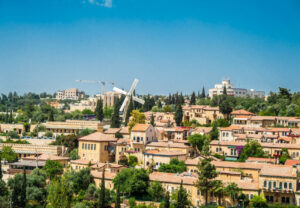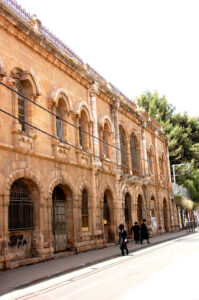Jewish Communities in Jerusalem
Moses Montefiore was more of a prophet than a reporter when he declared Jerusalem as ‘the city of our forefathers, the great and long-desired object of our wishes and journey’. Montefiore’s grasp of numbers (he had made his millions on the London Stock Exchange) must have escaped him when writing about his trip to Jerusalem in 1827. The Jewish population of the city was around 4,000, less than a third of the total population of Jerusalem, and around 0.1% of the world’s Jewish population. Not many Jews were going on journeys, let alone living in the city. Moses had little interest in religion before his trip to Jerusalem and so his gushing reads more as the recent convert than the shrewd appraiser. Judith, Montefiore’s wife, was perhaps more clear sighted when she described the city as ‘fallen, desolate and abject’. The squalor of the city and the dangers posed by bedouin raids on those outside the city walls reduced the appeal for Jews of visiting the city of their forefathers. The Montefiores’ wealth enabled them to make the journey which the vast majority of their fellow Jews could not. When Moses died in 1885, the situation was changing and by 1910, the Jews were the largest community in Jerusalem, numbering 45,000. Moses and Judith played their part in this remarkable growth, building houses for Jews in Jerusalem, fundraising and lobbying to help Jews travel to Jerusalem. They did so with a particular vision of Jerusalem in mind, not all Jews agreed with them. It was this heterogeneity in visions of a modern Jerusalem that drove the growth of the Jewish population in Jerusalem.
A community needs housing when its population increases by ninefold in just under a century and so Jewish building in Jerusalem was overwhelmingly residential in the nineteenth century. There were some architectural statements: Moses financed the rebuilding of the Hurva Synagogue in the Old City. The European powers could get on with their architectural competition but the primary motivation for Jewish building was to provide housing. Moses arranged the building of the first Jewish neighbourhood outside the Old City in 1859. This neighbourhood, called Mishkenot Sha’ananim, is easily recognisable, on a hill just to the west of the Old City, due to a white windmill that Moses financed for the residents. Then the Nahalat Shiv’a neighbourhood was built south of Jaffa Road in the 1860s, Mea She’arim in 1872 between Jaffa Road and the Road of the Prophets. Nine more neighbourhoods were constructed in the 1870s, and another sixty by 1914, predominantly along, and in between, Jaffa Road and the Road of the Prophets. Of the 45,000 Jews living in Jerusalem, over 25,000 lived in these new neighbourhoods to the west of the Old City.
MISHKENOT SHA’ANANIM
These neighbourhoods shared the same purpose – housing Jews – but their architecture varied considerably. Mishkenot Sha’ananim consists of two rows of English rural cottages, terraced together. Mea She’arim is a tightly enclosed neighbourhood of narrow streets and plain houses, built with local limestone and red tiled roofs, clustered around courtyards. The Bukharan quarter is full of luxurious mansions that borrow a mishmash of German and Italian elements: baroque arches, neo-Gothic windows, Italian marble. The majority of the neighbourhoods along Jaffa Road are similar in style- red tiled roofs, local limestone- to Mea She’arim but are less tightly enclosed with fewer courtyards. These neighbourhoods and Mea She’arim are variations on the same theme. These variations may not be as stark those with Mishkenot Sha’ananim and the Bukharan quarter but they are still noticeable. These variations are interesting because many of the early neighbourhoods that set the pattern for Jewish architecture in Jerusalem, including the more eccentric Bukharan quarter, were designed by one man: Conrad Schick.
YEHUDAYOFF PALACE IN THE BUKHARAN QUARTER
Conrad Schick was not a Jew but a German Protestant. He moved to Jerusalem in 1846 as part of the Templers, a German Lutheran sect that emigrated to Jerusalem to wait for the return of Christ. Schick left the Templers shortly after arriving in Jerusalem though and developed an interest in architecture. He became something like Jerusalem’s house architect until his death in 1901, responsible for the English church of St Paul, for the lepers’ hospice in the German colony, for the Lutheran hospice in the Old City, for extensive repairs to Muslim holy sites. Schick was fond of certain architectural elements such as a clock tower but the important point is that he built in a wide variety of styles for different clients. If Jewish buildings were heterogeneous in style and predominantly built using, or based on, the designs of one architect, then that heterogeneity is the reflection of those commissioning the buildings.
It is unlikely that Mishkenot Sha’ananim would have consisted of two rows of English rural cottages if they had not been commissioned by Moses Montefiore. Moses, an Italian-born Englishman, associated a ‘peaceful habitation’ (as the name means in Hebrew) with the English countryside. Beyond the twee postcard image though, Mishkenot Sha’ananim expresses Moses’ vision of a modern Jerusalem. He built the cottages to house poor Jews of Middle Eastern origin and living in the Old City, known as the Sephardim, and Eastern European Jews, known as the Ashkenazim. The Sephardim and the Ashkenazim worship in different styles and so Moses built a Sephardi synagogue at one end of the rows of cottages and an Ashkenazi synagogue at the other end. Moses intended Mishkenot Sha’ananim to be a new type of self-sufficient, sanitary settlement where Sephardi and Ashkenazi Jews lived together. Not everyone shared this vision. The building society that financed the construction of Mea She’arim intended for the neighbourhood to be an enclosed unit, complete with a large synagogue and a yeshiva (a religious school), for the most strictly religiously observant Eastern European Jews. The building society’s vision was one of Eastern European Jews cutting themselves off from anyone who did not follow their interpretation of Jewish law, and waiting for the coming of the Messiah. The Mamila neighbourhood was built for North African Jews and many other neighbourhoods were built for only Ashkenazi Jews or only for Sephardi Jews. The Bukhara quarter was built by Jews from Central Asia who stipulated that their ‘streets and marketplaces [are to be] built as in important European cities, and the arrangement and style of building should follow European practice’. Theirs was a vision of Jerusalem as an outpost of Europe, an embrace of another, and in their minds’ superior, civilisation.
Moses Montefiore was an individual philanthropist and other wealthy individuals did help finance the growth in Jewish neighbourhoods. The majority of the neighbourhoods though were built by building societies, collectives of future residents. Each had its own motivation for moving to Jerusalem and for building their neighbourhoods in the way they did: escape from the conditions of Jews in Europe, a desire to live, pray and wait for the Messiah, improvements in conditions in Jerusalem and, for some, a belief in building a Jewish national home. These drivers of migration to Jerusalem were also the drivers of Jewish buildings in Jerusalem, because of the system of building societies. The building societies bought the land from Muslim landowners or Christian churches. There was little interaction with any government and the newly arrived Jews rubbed along with the local Jews, Muslims and Christians. There were naturally tensions but nothing unusual in a mixed religious city. The most holy Jewish site, the Western Wall, remained undeveloped though. Jews could worship at the Wall so long as they did not disturb the Muslims who lived nearby and they did not claim ownership over the Wall. When rumours spread of Jewish plans to develop the Western Wall in 1929, the result was Muslim-Jewish violence, including several massacres of Jews. The extent of Jewish building had emboldened some Jews to become dissatisfied with the situation at the Wall. The extent of Jewish building had alarmed Muslims about Jewish intentions for the Wall. Diversity had driven Jewish development but that development now threatened to hide that diversity and replace it with the simple binary of Jew and Arab. 1929 did as much as any other moment to enshrine the binaries of Jew and Arab, West and East Jerusalem, binaries that are still supposed to describe the reality of Jerusalem.


